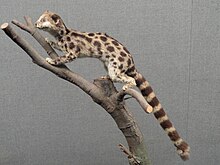Prionodon pardicolor
| Spotted linsang | |
|---|---|
 |
|
| Scientific classification | |
| Kingdom: | Animalia |
| Phylum: | Chordata |
| Class: | Mammalia |
| Order: | Carnivora |
| Family: | Viverridae |
| Subfamily: | Prionodontinae |
| Genus: | Prionodon |
| Species: | P. pardicolor |
| Binomial name | |
|
Prionodon pardicolor Hodgson, 1842 |
|
 |
|
| Spotted linsang range | |
The spotted linsang (Prionodon pardicolor) is a linsang found throughout much of Southeast Asia. It is widely, though usually sparsely, recorded, and listed as Least Concern by IUCN.
The spotted linsang resembles the banded linsang in its long, slender body, short limbs, elongated neck and head, and long tail. The ground colour ranges from dusky brown to light buff. Two long stripes extend from behind the ears to the shoulders or beyond, and two shorter stripes run along the neck. Three to four longitudinal rows of spots adorn the back, their size decreasing towards the belly. The fore legs are spotted to the paw, the hind legs to the hock. The cylindrical tail has eight or nine broad dark rings, separated by narrow white rings. The feet have five digits, and the area between the pads is covered with hair. The claws are retractile, claw sheath are present on the fore paws, but the hind-paws have protective lobes of skin. It weighs about 1 lb (0.45 kg) and measures in length from 14–15 in (36–38 cm), and the tail 12–13 in (30–33 cm). Its height is about 5–5.5 in (13–14 cm), the girth of its chest 5.75 in (14.6 cm), and length of head to the occiput about 3 in (7.6 cm).
The range of the spotted linsang includes eastern Nepal, Sikkim, Assam and Bengal in India, Bhutan, northeastern Myanmar, northern Thailand, Laos, northern Vietnam, and western Sichuan, Yunnan Guizhou and southwestern Guangxi in southern China. It is uncommon to rare throughout this range. It is rarely observed in northern Bengal.
The spotted linsang is nocturnal and solitary. It uses hollows in trees as resting and denning sites. It hunts on the ground and in trees and feeds on rodents, frogs and snakes. It was also observed feeding on carcass.
...
Wikipedia

